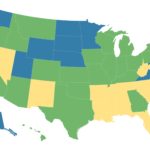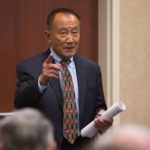Who will be Indian Country’s Obama? Look to the states. Her name will be Paulette, Peggy, or Denise.
By Mark Trahant
Yes! Magaazine, Jul 26, 2016 —

Yes! Illustration
This is the first of a two-part series on this political turning point for Native Americans.
Joe Garry was president of the National Congress of American Indians in an era when tribal rights were under assault from Congress. House Concurrent Resolution 108, passed in August 1953, declared that the federal government should “terminate” its responsibilities toward Native Americans, essentially breaking promises made through solemn treaties.
The threat was real. In a period of 30 years, more than a hundred tribes were disbanded and the tribal governments dissolved. The result was huge losses of land and natural resources in Oregon, Utah, Wisconsin, Oklahoma, Nebraska, and Texas.
The strongest weapon in this battle is the power to vote.
Garry’s plan to counter that threat included the addition of more Native American voices to the country’s conversations. The strongest weapon in this battle is the power to vote, Garry said.
So I’ll begin the story of Native America’s growing political voice in Idaho, where Garry was the chairman of the Coeur d’Alene tribe. He ran for the Idaho House of Representatives and was elected in 1957. Later, he won a seat in the the Idaho Senate, and in 1960 sought the Democratic Party’s nomination for the U.S. Senate.
Idaho is a surprising birthplace for Joe Garry’s legacy. Not many Native Americans live in Idaho, where they comprise roughly 1 percent of the population. Garry’s successes showed that someone from a tribal community could be a leader for all of the citizens in a state.

Joe Garry
In 1975, Garry’s niece Jeanne Givens became the first Native woman elected to the Idaho House of Representatives. Like her uncle, she challenged the status quo with a bid for Congress in 1988. Givens lost, but four years ago another Coeur d’Alene tribal member, Paulette Jordan, ran for the Idaho House seat. She lost that attempt but won in 2014, illustrating what may be the most important lesson in politics: You have to run to win—sometimes more than once. Jordan describes Givens as a mentor who has taught her much about politics. Both have earned the legacy of Joe Garry.
Larry Echo Hawk won a seat in the Idaho Legislature in 1992. After serving two terms he ran for and won election as the Bannock County prosecuting attorney—another first. Then, in 1990 he was elected attorney general of Idaho and became one of the few Native Americans to ever win a statewide office. Four years later he ran for governor, but he lost.
When a state like Idaho has a history of electing Native Americans to public office, you have to wonder, “Where else?” It has almost been a story of success-by-stealth.
There is a win in Arizona, another in Kansas. And when you add them up, there are at least 73 American Indians, Alaska Natives, and Native Hawaiians serving in 19 state legislatures.
When a state like Idaho has a history of electing Native Americans to public office, you have to wonder, “Where else?”
Why hasn’t the scope of this story been told before? Because each race is local; no one has ever collected all of the data that make a complete picture. So at the start of the election season I set out to build a complete list of Native Americans running for state and federal office. My list is always changing, but there are seven candidates for the U.S. House of Representatives, one for the U.S. Senate, and some 80 state legislative candidates. (What I really like is that it’s crowdsourced: Every time I publish the latest candidate charts at TrahantReports.com, readers let me know who I have missed.)
I’d love to proclaim this to be a record year, but there’s nothing to measure against. We don’t know how many Native Americans have taken the plunge in previous election cycles. We do know, however, who has won.

Denise Juneau
One source for that information is membership in the National Caucus of Native American State Legislators. This is an association of people already elected, so it tells us more about what happened in 2014 than in 2016. Still, it’s important for three reasons: First, if you look at the body of work of these state senators and representatives, you’ll find that they advocate for better services, more funding, and improving relationships between tribal nations and state governments. Second, there is a mechanism to share information with each other about what works (and what does not). And third, this association is the talent pool for federal posts, from Congress to the White House.
Remember, it was just 1996 when Barack Obama was elected to the Illinois Senate.
To see the growing influence of Native Americans elected to office we need only to look at Montana.
Right now, the big story there is Denise Juneau, the state’s superintendent of public instruction, who is running for the U.S. House of Representatives. She’s a member of the Mandan and Hidatsa tribes and grew up in the Blackfeet Nation in Browning, Montana. She has already won two statewide contests, so she knows what it takes to win Montana’s only U.S. House seat. If successful, she (along with Arizona congressional candidate Victoria Steele) would be the first American Indian woman in Congress.
To see the growing influence of Native Americans elected to office we need only to look at Montana.
Yet the Montana story is richer than just Juneau. Some 20 years ago, Montana was much like any other state with a significant Native American population with only one or two Native Americans serving in the state Legislature. But in 1997, a third Native American candidate won. And again in 2003. By 2007, Native Americans in Montana occupied 10 seats in the state Legislature—6.6 percent of that body. Montana’s population is 7.4 percent Native American.
Today there are three Native Americans in the Montana Senate and five in the Montana House of Representatives, some 5.3 percent of the state Legislature. This is the highest percentage of Native American representation in the country.
Let’s put the Montana percentages in national terms: If Congress were 5.3 percent Native American, that would be five U.S. Senators and 21 members of the U.S. House of Representatives. Even if you adjust for population, the number of Native American members of Congress would have to more than double to equal the representation found in Montana.

YES! Infographic by Tracy Loeffelholz Dunn.
After the 2016 election, Montana’s state-level Native representation is likely to grow. There are 11 Native American candidates on Montana’s ballot this year, including Juneau.
Montana’s Native American legislators are in office to raise overlooked issues that are important to their constituents. According to the Montana Budget and Policy Center, this past session produced a number of innovative laws, including Medicaid expansion (a financial boost to the Indian health system) and laws that will improve funding for tribal colleges, support for tribal languages, and streamline Indian business ventures. The success rate of Native American legislators to push through policy changes was less than perfect, but their voices were heard. It’s likely that during the next session many of the ideas that failed to pass will be back on the agenda.
Native voters and elected officials are only at the beginning of a demographic trend.
At nearly 1 percent nationwide, the Native American rate of representation in state legislatures still trails that of the nation’s overall population of American Indians, Alaska Natives, and Native Hawaiians. But that’s more than half of the 1.7 percent that make up the Native American population in the United States. Compare that to Congress, where only two elected Native Americans equal only 0.33 percent. Compare that to the federal judiciary, where only one Native American judge equals a representation of about 0.1 percent.
Then consider the young and growing Native American population. Native voters and elected officials are only at the beginning of a demographic trend. The American Indian and Alaska Native population is younger and growing faster than the general population. About one-third of all Native Americans are under the age of 18 (compared to 24 percent for the total population), and the median age for Native Americans is 26 (compared to 37 for the nation).
While it’s overdue for America’s first citizens to have a voice in how governments are run and how the country’s future is shaped, it is happening now. Just imagine what it could mean for climate change policy decisions, for example, to hear from people who think about the future in terms of a 10,000-year history. Imagine also the healing message for a new generation of Native Americans—and for the country as a whole—to finally see in positions of power the people who suffered loss of both lands and culture and genocide.

YES! Infographic by Tracy Loeffelholz Dunn
This is a story that has been unfolding slowly, chapter by chapter. It started even before Joe Garry, when 19th century tribal treaty negotiators demanded a seat in Congress (a promise never kept). It’s a legacy that is infused with presidential politics, especially when candidates like Jesse Jackson, Barack Obama, Bernie Sanders, and Hillary Clinton campaign in tribal communities. The election of Obama elevated the possible. He kept his promises to include tribal nations in his government and in his actions. His rise from community organizer representing poor Black communities illuminated a path to meaningful politics.
This is a story that’s been unfolding slowly, chapter by chapter.
It’s also a progressive legacy, of which Minnesota Rep. Peggy Flanagan of the White Earth Ojibwe tribe is an excellent example. Flanagan told The Circle when she was elected, “I have been clear that for myself personally as an Ojibwe woman and mother—but also what I’ve heard from my constituents—is that Minnesotans believe in protecting our land and water. That’s why people live here in the first place. Indian or non-Indian, we live in a really beautiful state, and to throw it all away for short-term financial gain is really troubling to me.”
It’s hard to look across the country and not be optimistic about the quality, and the growing quantity, of Native American political voices. We know the story won’t end here because history tells us that state legislatures are the route that leads the next generation of leaders into Congress—and one day the White House.
So if you want to know who will be Indian Country’s Barack Obama, look to the states. Her name will be Paulette Jordan, Peggy Flanagan, or Denise Juneau.
And whoever she is, she will represent Joe Garry’s legacy.
Part 2: Denise Juneau and a Historic Push for Congress
Mark Trahant wrote this article for YES! Magazine. Mark is an independent journalist and a journalism professor at the University of North Dakota. He’s a member of the Shoshone-Bannock tribes. His most recent project, TrahantReports.com, covers the 2016 election focusing on American Indian and Alaska Native issues and candidates. Follow him on Twitter at @NewsRimes4lines.











